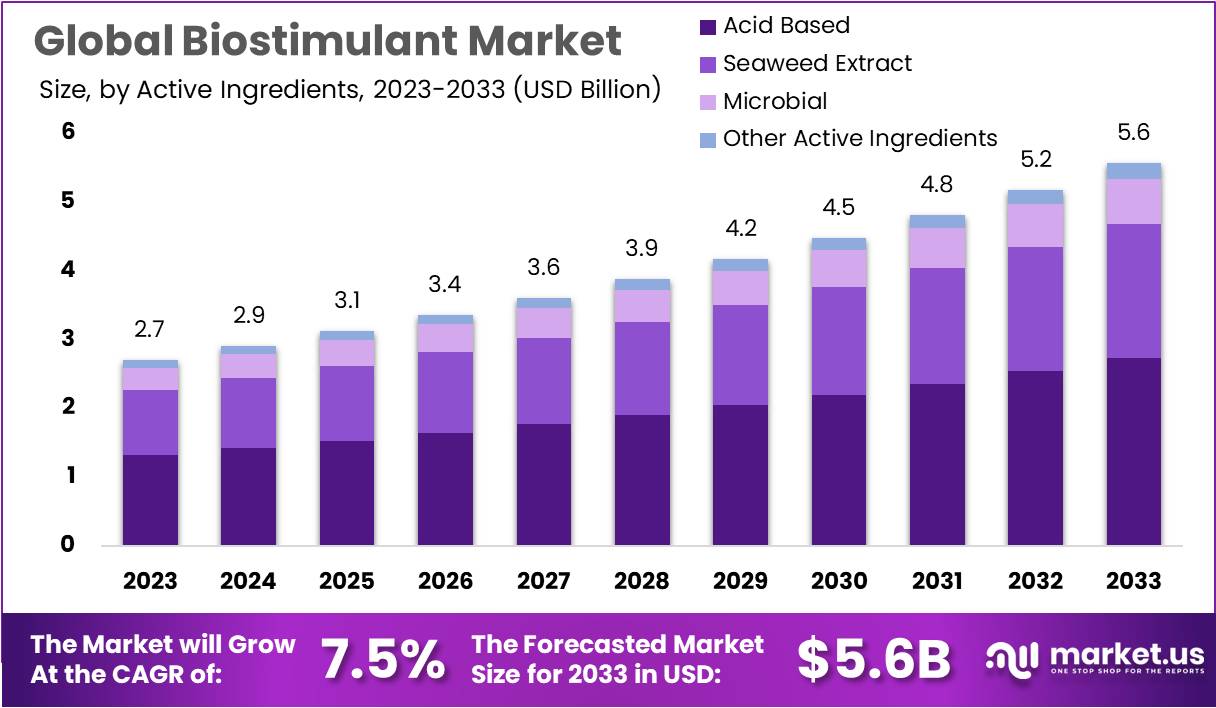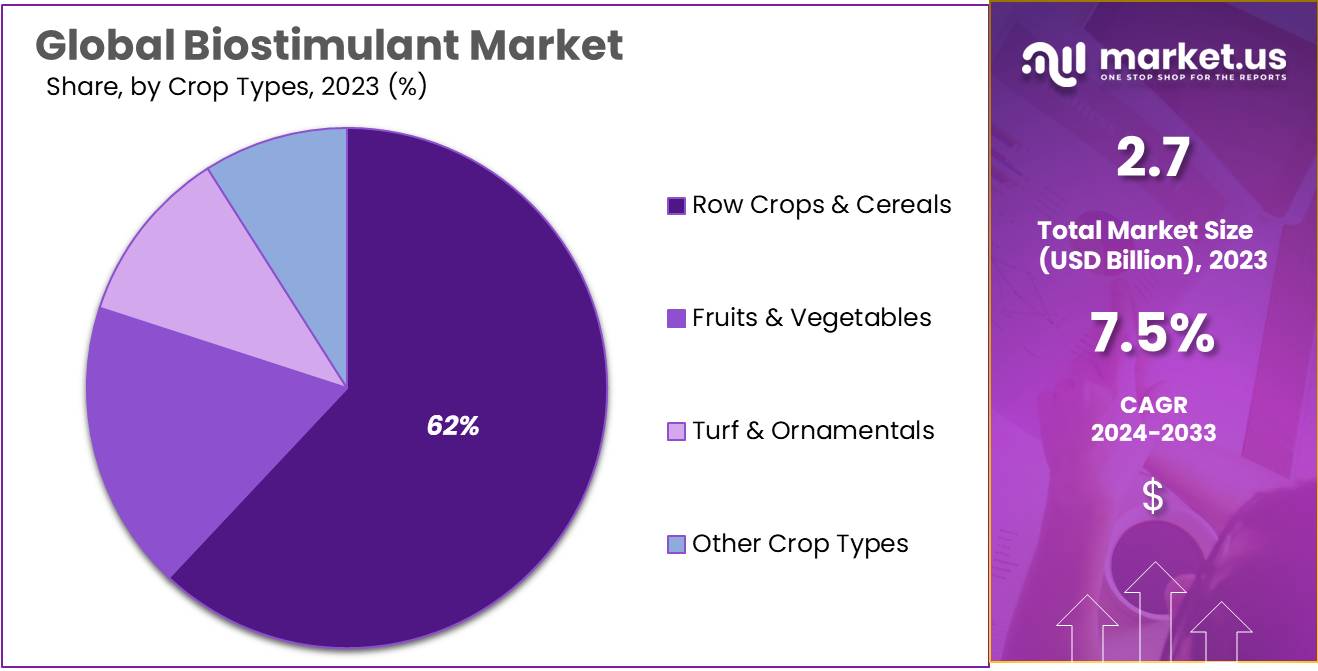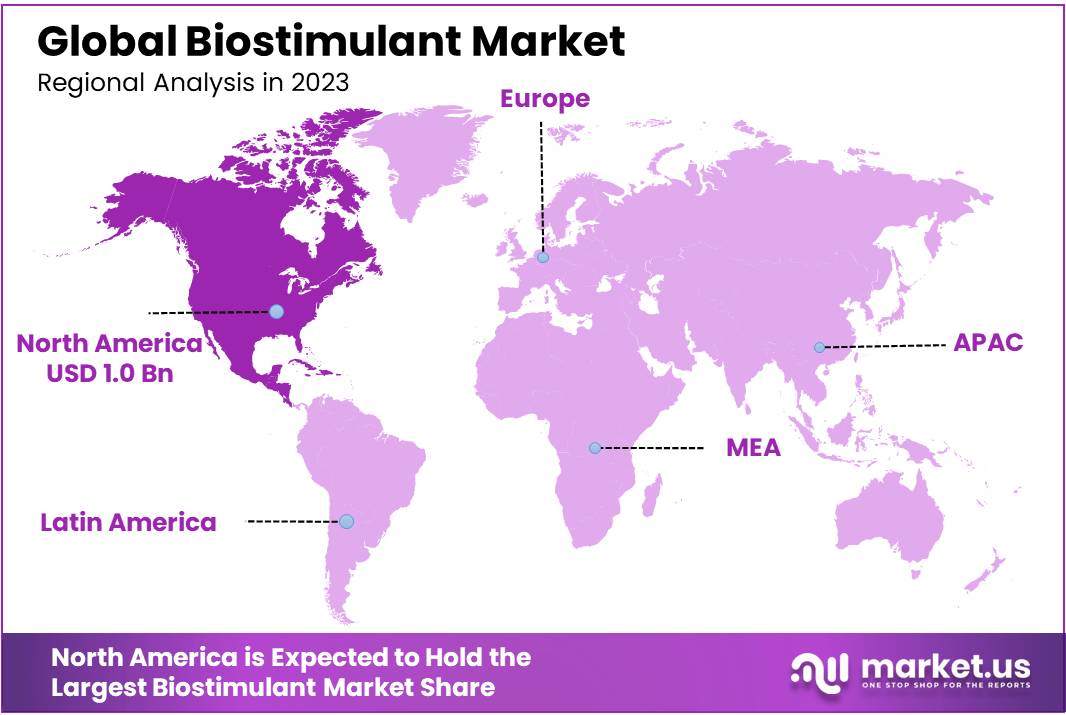Global Biostimulant Market Analysis By Active Ingredients (Acid-based, Seaweed Extract, Microbial, Other Active Ingredients), By Crop Type (Row Crops & Cereals, Fruits & Vegetables, Turf and Ornamentals, Other Crop Type), By Application (Foliar Treatment, Soil Treatment, Seed Treatment), By Region and Companies - Industry Segment Outlook, Market Assessment, Competition Scenario, Trends and Forecast 2024-2033
- Published date: Nov 2023
- Report ID: 47860
- Number of Pages: 360
- Format:
- keyboard_arrow_up
Quick Navigation
Report Overview
The Biostimulant Market Size is anticipated to reach approximately USD 5.6 billion by the year 2033, reflecting significant growth from its estimated value of USD 2.7 billion in 2023. This projected expansion signifies a compound annual growth rate (CAGR) of 7.5% throughout the forecast period spanning from 2024 to 2033.

A biostimulant is a substance or microorganism applied to plants or soils to improve nutrient uptake, efficiency, stress tolerance, and overall crop quality. Unlike conventional fertilizers, which primarily provide essential nutrients, biostimulants focus on enhancing plant health and performance. They encompass various compounds like humic acids, fulvic acids, seaweed extracts, amino acids, and beneficial microorganisms.
These components work synergistically to foster processes such as root development, nutrient absorption, stress resilience, and metabolic modulation. It’s crucial to understand that biostimulants complement rather than replace fertilizers, optimizing the plant’s capacity to absorb and utilize nutrients effectively. Their integration into modern agriculture aims to promote sustainability, minimize environmental impact, and boost crop productivity.
The biostimulant market has seen robust growth due to the global shift towards sustainable agriculture. Farmers increasingly appreciate the benefits of integrating biostimulants with traditional fertilizers, driven by stringent environmental regulations. Ongoing research and development efforts are yielding innovative formulations to enhance biostimulant efficacy, meeting the rising demand for eco-friendly solutions.
The push for organic products and strategic industry collaborations further propel market expansion. This dynamic sector responds to consumer preferences, emphasizing sustainability and navigating regulatory changes while contributing to a more environmentally conscious approach in agriculture.
Key Takeaways
- The global Biostimulant Market size was valued at USD 2.7 billion in 2023.
- The market is expected to grow at a CAGR of 7.5% between 2024 and 2033.
- By 2033, the Biostimulant Market size is projected to reach around USD 5.6 billion, up from USD 2.7 billion in 2023.
- The growth is driven by soil degradation and strict regulations against chemical use in agriculture.
- Acid-based active ingredients accounted for over 49% of total revenue in 2023.
- Row crops and cereals were the dominant crop type in 2023, with over 62% market share.
- Europe led the market in 2023, with over 38.5% of total revenue, driven by the demand for organic foods.
Active Ingredients Analysis
Globally, the acid-based active ingredients segment was dominant and accounted for over 49% of total revenue in 2023. These ingredients are highly sought after due to their potency enhancement properties and sustainability. They are also economically viable. They are also economically feasible. amino acids like fulvic acid and humic acid are key instigators for plant hormones that stimulate metabolic processes and improve seed germination.
Seaweed extracts are biostimulants because they present plant growth hormones such as auxins and cytokines. The most widely used seaweed extracts are brown, green, and red algae. The growth rate of microbial biostimulants is expected to be moderate over the predicted time. These include using microorganisms or a combination of microorganisms to stimulate plant growth. Bacteria, yeasts, and fungi commonly use microbial biostimulants. They aid the plant in coping with stress and rise its nutritional absorption.
Crop Type Analysis
With the largest market share of over 62%, the row crops and cereals segment was dominant in 2023. This segment includes crops like cotton, soybean, millet, and barley. These crops provide companies with growth opportunities and can be grown over vast agricultural land areas. It increases the size and harvest of the seeds as well as the rate of cell division.
The key biostimulants in cereals and row crops are amino acids, Polyamines (IAA), and Indole-3-acetic Acid. It can overcome different barriers that prevent cell division and development. multinationals and agricultural experts are increasingly using the demand for the biostimulant industry to cultivate cereals and row crops.
The demand for organic cereals like oats or millet is expected to boost the segment’s growth. The market is expected to see tremendous growth opportunities due to increasing acceptance and recognition of sustainable and ecological organic farming to meet rising food demand. Due to increased turf and ornamental usage worldwide, Turf and Ornamental were the second-largest segments in 2023.

Application Analysis
In 2023, Foliar treatment segment held a dominant market position, capturing more than a 80% share. This Foliar treatment has many benefits, including increased cellular activity and faster absorption of nutrients. Foliar treatment involves directly applying biostimulants to plant leaves to aid the rapid absorption of nutrients. The epidermis, stomata, and other surface elements of the leaves facilitate absorption. To facilitate easy application and absorption, biostimulants are often in liquid form for foliar treatment. Seed treatment is cost-effective and efficient. It requires less labor than other methods.
The industry is also driven by an increasing population, rising demand for organic products, and encouragement from the government to use biostimulants. Biostimulants are used in soil treatment to increase fertility and productivity. The four main soil treatment methods are physical, chemical, biological, and mechanical. A decrease in chemical use in agriculture will increase soil treatment product usage. Acid-based and microbial biostimulants are the most commonly used biostimulants in soil treatment.
Key Market Segments
Active Ingredients
- Acid-based
- Seaweed Extract
- Microbial
- Other Active Ingredients
Crop Type
- Row Crops & Cereals
- Fruits & Vegetables
- Turf and Ornamentals
- Other Crop Type
Application
- Foliar Treatment
- Soil Treatment
- Seed Treatment
Drivers
Sustainability, Government Support, and Organic Farming
The increasing demand for sustainable agriculture is fueled by a growing awareness of environmental impact. Biostimulants, allowing farmers to enhance crop yields while minimizing ecological harm, are a key focus. Supportive government policies and regulations, including subsidies and incentives, contribute significantly to market growth, encouraging widespread adoption. Additionally, the rising emphasis on organic farming practices globally is a driving force. Biostimulants, integral to organic agriculture, aid in plant growth and nutrient uptake, aligning with the broader shift toward environmentally friendly and sustainable farming methods.
Restraints
Navigating Research Costs, Farmer Awareness, Regulatory Processes, and Fertilizer Competition
The formidable obstacle of high research and development costs acts as a major deterrent for smaller companies attempting to enter the biostimulant market. This financial barrier stems from the substantial initial investment required. Additionally, there is a pervasive lack of awareness among farmers, particularly in developing regions, about the benefits of biostimulants. Overcoming this challenge necessitates comprehensive education and outreach programs.
Further complicating matters are the stringent and time-consuming regulatory approval processes for biostimulant products, posing a significant hurdle, especially for smaller enterprises. Moreover, the enduring dominance of traditional chemical fertilizers in the agriculture sector creates fierce competition. Convincing farmers to transition to biostimulants proves difficult without clear and immediate economic incentives.
Opportunities
The Emerging Landscape of Biostimulants in Developing Economies and Sustainable Agriculture
In the dynamic landscape of the biostimulant market, untapped potential lies in emerging economies, where heightened awareness and economic development are poised to drive the adoption of biostimulants. Collaborations between manufacturers and agricultural entities, research institutions, or government bodies stand as strategic pathways for product enhancement and market expansion. Ongoing innovations in formulations, incorporating novel ingredients and advanced delivery mechanisms, offer companies a chance to distinguish their offerings. Furthermore, the global emphasis on sustainable agricultural practices positions biostimulant manufacturers to meet the rising demand for eco-friendly alternatives, aligning with the push for sustainable solutions.
Trends
Emerging Trends in Biostimulant Adoption and Agricultural Innovation
The rising adoption of biostimulants in specialty crops like fruits and vegetables is noteworthy, given their higher value and the pronounced benefits of biostimulants. A growing trend involves integrating biostimulants with precision agriculture practices, leveraging data-driven technologies for targeted applications and optimal results. Additionally, there’s a noticeable shift towards using biological-based ingredients in biostimulant formulations, aligning with consumer preferences for natural and sustainable products. Another emerging trend is the digitalization of agriculture for biostimulant management, with the adoption of technologies like monitoring and data analytics, enhancing precision and overall efficiency in farming practices.
Regional Analysis
In 2023, Europe held a dominant market position, capturing more than a 38.5% share and holds USD 1.0 Bn market value for the year. The large share is attributed to the high adoption of biostimulants among farmers and growers in the region. Countries like Spain, Italy, France and Germany are the key markets, driven by favorable government policies, rising awareness of sustainable agriculture practices, and increasing need to improve crop quality and yields.
North America closely tracks Europe in market influence, securing more than moderate market share. Key players in the U.S. and Canada are driving advancements in research and product innovations, supported by regulatory backing and subsidies for biostimulant adoption. The Asia Pacific is anticipated to experience the highest growth rate in the foreseeable future. Factors such as rapid population growth, diminishing arable land, initiatives to enhance agricultural productivity, and government funding in significant countries like China and India are expected to drive regional growth.
Latin America and Middle East & Africa currently hold modest market shares, but offer promising growth opportunities. Expanding populations, need for food security and focus on agricultural development is creating conducive conditions. As more players turn focus on these untapped markets, substantial growth can be achieved through appropriate positioning and pricing strategies suited for the regions. Overall, the global biostimulant market remains in the growth stage and has bright prospects across both developed and developing regional markets over the forecast period.

Key Regions
- North America
- The US
- Canada
- Mexico
- Western Europe
- Germany
- France
- The UK
- Spain
- Italy
- Portugal
- Ireland
- Austria
- Switzerland
- Benelux
- Nordic
- Rest of Western Europe
- Eastern Europe
- Russia
- Poland
- The Czech Republic
- Greece
- Rest of Eastern Europe
- APAC
- China
- Japan
- South Korea
- India
- Australia & New Zealand
- Indonesia
- Malaysia
- Philippines
- Singapore
- Thailand
- Vietnam
- Rest of APAC
- Latin America
- Brazil
- Colombia
- Chile
- Argentina
- Costa Rica
- Rest of Latin America
- Middle East & Africa
- Algeria
- Egypt
- Israel
- Kuwait
- Nigeria
- Saudi Arabia
- South Africa
- Turkey
- United Arab Emirates
- Rest of MEA
Key Players Analysis
The competition in this market is highly dependent on the crop type, active ingredient type, grade of products, number of sellers/manufacturers, and geographical location. Key companies engage in continuous R&D, mergers and acquisitions, capacity expansion, and other strategies to gain a competitive landscape in this market. Manufacturers focus on increasing their product portfolios through strategic joint ventures and high R&D investments.
Major players have made substantial investments in innovation in recent years to meet the growing demand for agricultural products globally. They also help companies develop new sustainable products and increase their profit margins. Isagro Group purchased Phoenix Del in 2020 to expand its product range of copper-based fungicides. This acquisition promoted technological advancement and revolutionized products under the “BioSolutions” segment.
The following are some of the most prominent market players in the global biostimulant market: Isagro Group, BASF SE, Biolchim SpA, Sapec Agro S.A., Platform Specialty Products Corp., Novozymes A/S, Adama ltd, Valagro SpA, Italpollina SAP, biostat India limited Other Key Players.
Market Key Players
- Bayer AG
- Isagro Group
- BASF SE
- Biolchim S.P.A.
- Novozymes A/S
- Valagro SpA
- Koppert B.V.
- Biostadt India Limited
- Marrrone Bio Innovations
- Syngenta AG
Recent Developments
- In August 2023, Lallemand, known for its expertise in yeast and bacteria fermentation, successfully acquired Biotalys, a company specializing in innovative biostimulants and biocontrol solutions. This strategic move, valued at $1.1 billion, is set to bolster Lallemand’s standing in the biostimulant market, presenting a promising avenue for future growth.
- In June 2023, Novozymes, a prominent figure in bioinnovation, introduced ProTera, a groundbreaking biostimulant demonstrating the potential to enhance crop yields by up to 15%. ProTera, a natural product, achieves this by optimizing the plant’s nutrient absorption and water utilization.
- In May 2023, witnessed a significant collaboration between BASF, a global chemical leader, and Corteva Agriscience, renowned in the field of agriculture. Together, they forged a strategic alliance with the goal of developing cutting-edge biostimulants. This collaboration harnesses BASF’s prowess in chemistry and Corteva’s agricultural expertise to create products aimed at helping farmers enhance both crop yields and quality.
Report Scope
Report Features Description Market Value (2023) USD 2.7 Bn Forecast Revenue (2033) USD 5.6 Bn CAGR (2024-2033) 7.5% Base Year for Estimation 2023 Historic Period 2017-2022 Forecast Period 2024-2033 Report Coverage Revenue Forecast, Market Dynamics, COVID-19 Impact, Competitive Landscape, Recent Developments Segments Covered By Active Ingredients (Acid-based, Seaweed Extract, Microbial, Other Active Ingredients), By Crop Type (Row Crops & Cereals, Fruits & Vegetables, Turf and Ornamentals, Other Crop Type), By Application (Foliar Treatment, Soil Treatment, Seed Treatment) Regional Analysis North America – The US, Canada, & Mexico; Western Europe – Germany, France, The UK, Spain, Italy, Portugal, Ireland, Austria, Switzerland, Benelux, Nordic, & Rest of Western Europe; Eastern Europe – Russia, Poland, The Czech Republic, Greece, & Rest of Eastern Europe; APAC – China, Japan, South Korea, India, Australia & New Zealand, Indonesia, Malaysia, Philippines, Singapore, Thailand, Vietnam, & Rest of APAC; Latin America – Brazil, Colombia, Chile, Argentina, Costa Rica, & Rest of Latin America; Middle East & Africa – Algeria, Egypt, Israel, Kuwait, Nigeria, Saudi Arabia, South Africa, Turkey, United Arab Emirates, & Rest of MEA Competitive Landscape Bayer AG, Isagro Group, BASF SE, Biolchim S.P.A., Novozymes A/S, Valagro SpA, Koppert B.V., Biostadt India Limited, Marrrone Bio Innovations, Syngenta AG Customization Scope Customization for segments, region/country-level will be provided. Moreover, additional customization can be done based on the requirements. Purchase Options We have three licenses to opt for: Single User License, Multi-User License (Up to 5 Users), Corporate Use License (Unlimited User and Printable PDF) 
- Bayer AG Company Profile
- Isagro Group
- BASF SE Company Profile
- Biolchim S.P.A.
- Novozymes A/S
- Valagro SpA
- Koppert B.V.
- Biostadt India Limited
- Marrrone Bio Innovations
- Syngenta AG
- settingsSettings
Our Clients
| Single User $4,599 $3,499 USD / per unit save 24% | Multi User $5,999 $4,299 USD / per unit save 28% | Corporate User $7,299 $4,999 USD / per unit save 32% | |
|---|---|---|---|
| e-Access | |||
| Report Library Access | |||
| Data Set (Excel) | |||
| Company Profile Library Access | |||
| Interactive Dashboard | |||
| Free Custumization | No | up to 10 hrs work | up to 30 hrs work |
| Accessibility | 1 User | 2-5 User | Unlimited |
| Analyst Support | up to 20 hrs | up to 40 hrs | up to 50 hrs |
| Benefit | Up to 20% off on next purchase | Up to 25% off on next purchase | Up to 30% off on next purchase |
| Buy Now ($ 3,499) | Buy Now ($ 4,299) | Buy Now ($ 4,999) |












